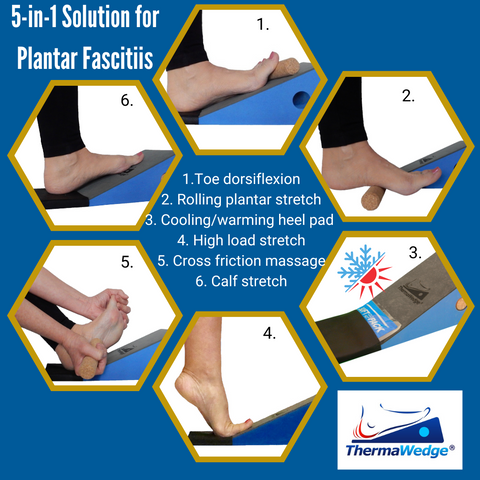Your Cart is Empty
⭐ Trusted by top athletes from LIV Golf, CFL, NFL & Alpine Canada ⭐
⭐ Trusted by top athletes from LIV Golf, CFL, NFL & Alpine Canada ⭐
Shop
Products
Stepping Pain-Free: Your Guide to Understanding and Treating Plantar Fasciitis
March 07, 2024 4 min read

Plantar Fasciitis: Causes, Symptoms, and Treatment
Plantar fasciitis is a common foot condition that affects millions of people worldwide (Searing, 2019) . It can cause significant discomfort and impact daily activities if left untreated. We will explore what plantar fasciitis is, its symptoms and causes, and effective treatment options to alleviate pain and promote healing.
Plantar fasciitis is a condition characterised by inflammation of the plantar fascia, a thick band of tissue that connects the heel bone to the toes. This inflammation can result in stabbing pain in the heel or bottom of the foot, especially with the first steps in the morning or after long periods of rest (Rachel, Kim, Kyle, & Robert, 2014). Some individuals may also experience stiffness and swelling in the affected foot.

Symptoms can also make themselves known with exercise after long periods of standing or prolonged sitting. It has been found that people who are overweight, female, or over the age of 40 are more likely to develop plantar faciitis (Schon, Karli, Anderson, Gould, & Zhang, 2020). Individuals who run and jog or have poorly fitted footwear are also susceptible. The pain may also worsen after exercise or prolonged activity.
The most common symptom of plantar fasciitis is heel pain, particularly when taking the first steps after waking up in the morning or after prolonged periods of sitting or standing. Plantar fasciitis often develops when the plantar fascia is overstretched or overused, leading to small tears in the tissue. Several factors can contribute to the development of plantar fasciitis, including (Schon, Karli, Anderson, Gould, & Zhang, 2020) :
- Overpronation or flat feet, which can increase strain on the plantar fascia.
- Excessive physical activity or a sudden increase in activity levels.
- Obesity, or being overweight, puts additional stress on the feet.
- Wearing unsupportive footwear or shoes with inadequate arch support.
- Tight calf muscles or Achilles tendon.
- Certain occupations or activities that involve prolonged standing or walking on hard surfaces.
Treatment Options for Plantar Fasciitis
Fortunately, there are several effective treatment options available to manage plantar fasciitis and alleviate symptoms:

- Rest: Giving the affected foot adequate rest is crucial to allowing the plantar fascia to heal. Avoid activities that exacerbate the pain, and consider temporarily switching to low-impact exercises such as swimming or cycling (“Home Remedies & Prevention for Plantar Fasciitis Pain,” 2017). A walking boot may be employed, depending on the severity, as a means to provide rest.
- Ice Therapy: Applying ice to the affected area can help reduce inflammation and alleviate pain. Ice can be applied for 15-20 minutes several times a day, especially after activities that aggravate the symptoms (“Plantar Fasciitis - Diagnosis and Treatment - Mayo Clinic,” 2023). It's always important to discuss icing with your primary health care provider, as it may not be appropriate for some who may have preexisting conditions like neuropathy.
- Stretching Exercises: Gentle stretching exercises targeting the calf muscles and Achilles tendon can help alleviate tension in the plantar fascia. Incorporate stretches into your daily routine, especially before getting out of bed in the morning (Carlton & Mark, 2013). The ThermaWedge is a great tool for this as it has a wedge, an icepack, and a foot roller combined as a unit.
- Supportive Footwear: Invest in supportive shoes with good arch support and cushioning to reduce strain on the plantar fascia. Avoid wearing worn-out shoes or those with inadequate support. It's advisable to gain assistance from individuals who understand how to fit shoes properly, particularly for running, to ensure the best style shoe for your individual needs. Rolling the feet out after wearing shoes for long periods of time with a foot roller, or spike ball often provides relief.
- Orthotic Devices: Custom or over-the-counter orthotic devices, such as shoe inserts or heel cups, can provide additional support and cushioning to the arch of the foot, helping to alleviate pain and promote proper foot alignment (Carlton & Mark, 2013). There are many on the market; a podiatrist may be able to provide a list of options or make a device specific to you and your personal needs.
- Physical Therapy: A physical therapist can prescribe specific exercises and techniques to strengthen the muscles of the foot and ankle, improve flexibility, and promote proper biomechanics (“Plantar Fasciitis - Diagnosis and Treatment - Mayo Clinic,” 2023). Some clinics will have ultrasound and shockwave therapy devices, which could be used as an adjunct to your treatment.
- Medications: Over-the-counter nonsteroidal anti-inflammatory drugs (NSAIDs) such as ibuprofen or naproxen can help reduce pain and inflammation associated with plantar fasciitis (“Plantar Fasciitis - Diagnosis and Treatment - Mayo Clinic,” 2023). However, it's essential to use them as directed and consult a healthcare professional if you have any concerns.
In some cases, more advanced treatments, such as corticosteroid injections, extracorporeal shockwave therapy, or surgery, may be recommended for severe or persistent cases of plantar fasciitis (“Plantar Fasciitis - Diagnosis and Treatment - Mayo Clinic,” 2023) . However, these options are typically reserved for cases that do not respond to conservative treatments. In most cases of plantar fasciitis, conservative treatment approaches will be exhausted before moving into more aggressive approaches.
Plantar fasciitis can be a debilitating condition, but with the right approach, it is usually manageable and can resolve over time. By understanding the causes, symptoms, and treatment options for plantar fasciitis, individuals can take proactive steps to alleviate pain, promote healing, and prevent recurrence. If you're experiencing persistent or severe foot pain, it's essential to consult a healthcare professional for an accurate diagnosis and a personalised treatment plan. With patience and diligence, most individuals can find relief from plantar fasciitis and resume their normal activities without discomfort.
References:
Carlton, & Mark. (2013).Plantar fasciitis: How best to treat. Retrieved from https://cdn.mdedge.com/files/s3fs-public/Document/September-2017/6209_JFP_Article1_0.pdf
Home Remedies & Prevention for Plantar Fasciitis Pain. (2017, June 4). Retrieved February 27, 2024, from https://www.webmd.com/fitness-exercise/what-can-i-do-plantar-fasciitis
Plantar Fasciitis - Diagnosis and Treatment - Mayo Clinic. (2023, September 7). Retrieved February 27, 2024, from https://www.mayoclinic.org/diseases-conditions/plantar-fasciitis/diagnosis-treatment/drc-20354851
Rachel, Kim, Kyle, & Robert. (2014).Plantar fasciitis: what is the diagnosis and treatment? Retrieved from https://journals.lww.com/orthopaedicnursing/fulltext/2014/07000/Plantar_Fasciitis__What_Is_the_Diagnosis_and.7.aspx
Schon, L. C., Karli, D. C., Anderson, R. B., Gould, H. P., & Zhang, Z. (2020, January 1). Plantar Fasciitis - an Overview | ScienceDirect Topics. https://doi.org/10.1016/b978-0-323-54942-4.00029-4
Searing, L. (2019, November 25). The Big Number: 2 Million Americans Get Treated for Heel Pain Caused by Plantar Fasciitis. Retrieved February 27, 2024, from https://www.washingtonpost.com/health/the-big-number-2-million-americans-get-treated-for-heel-pain-caused-by-plantar-fasciitis/2019/11/22/0dfe89e8-0c7a-11ea-97ac-a7ccc8dd1ebc_story.html
Subscribe
Sign up to get the latest on sales, new releases and more …

